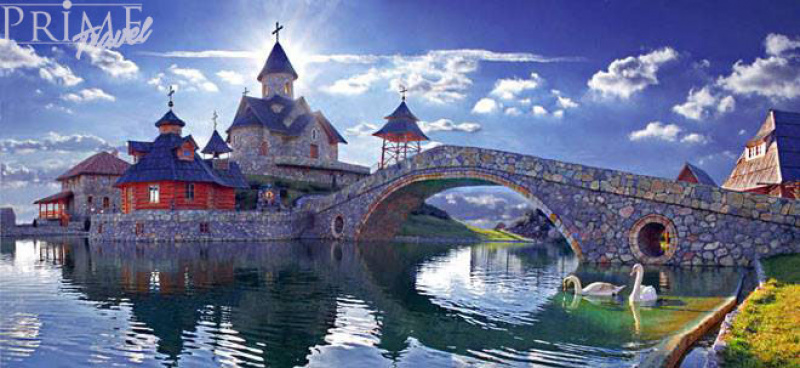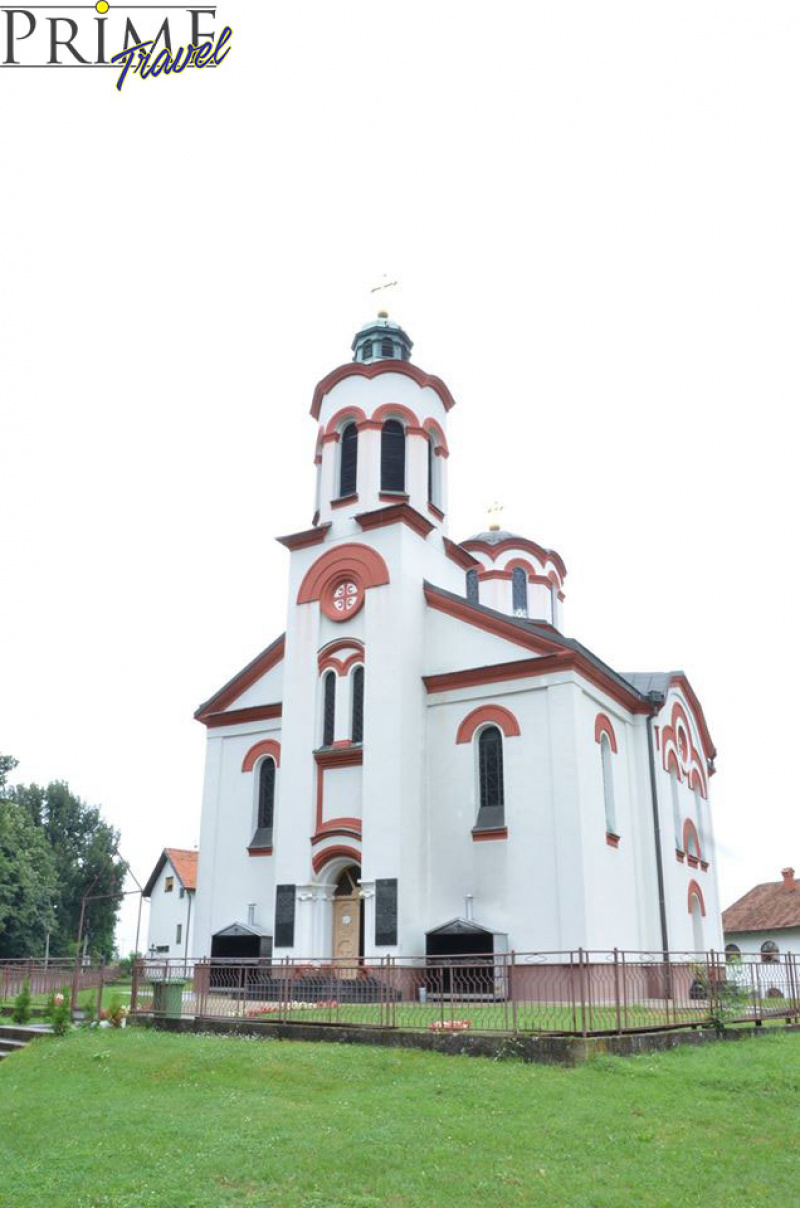


















Price: Contact us
Bijeljina is a city in the northwestern part of Bosnia and Herzegovina, and was first mentioned in 1446. From Zvornik through Bijeljina passed the medieval road leading up to the Macva, Mitrovica and Hoku. The Franciscan Monastery of Saint Mary, in fields, in the vicinity of Bijeljina was mentioned in 1514. To this period belongs thirteen tombstones, two of them are decorated, and on four are fragmentary legible inscriptions. In the village of Mitrovica, the village of Gornji Dragaljevac, at two sites are three tombstones, one of them is decorated with plants stylization and presentation of animals and was moved to the building Dragaljevac´ elementary school. In the Turkish period Bijeljina parishes belongs to nahija Koray. As the seat of Kaza it is mentioned in year 1,634. The city was destroyed in the period of Austrian occupation and during the war in 1876.
Sights you can visit in Bijeljina:
Tavna Monastery
Below the monastery property the river Tavna is flowing, a tributary of the Drina.
It is not known whether the monastery is named after the watercourse or vice versa. Legend says that the clear mountain rivers turned black with blood after a hard fight. The river got darker, because of that she got the name Tamna, based on a strange voice change she got the current name Tamna.
The folk tradition attributed the emergence of the monastery to the time of Nemanjići - more precisely to the king Dragutin, who also ran this region, and was also known by the name of King of Srem. It was mentioned at the earliest Turkish defterler of 1533 and 1548, and from 1548 to 1586 it is explicitly mentioned as a monastery.
On the gentle slopes of Majevica, which slightly hang over the Drina River and Sembers flat land, monks lived in peace and pray until 1461, when this area also came under Ottoman rule.
The monastery was often attacked by the Turks, but it was renewed by the brigands. The traditional heritage links one renewal to Starina Novak, to the chieftain of the second half of the sixteenth century, and his brother Radivoj.
Monastery of St. Petka
Monastery of St. Petka is located on the edge of the village of Lake Five. It is dedicated to Prepodobnoj mother Paraskevi. This monumental building with domes daily attracts the attention of passengers as they pass detour around Bijeljina leading to Serbia. It is a female monastery and is still under construction.
In the monastery there are particles from Sergej Radonjesk´, which bishop of Zvornik and Tuzla Vasilije received as a gift from the Russian Patriarch Alexy II.
The Temple built in the Russian style dominates now on the Fertile Semberija flat land, where people believing together with monasticism evokes the grace of God and the grace of saint in whose honor it was built. The monastery is adorned with five golden domes. In Russia it is customary that the monastery has two parts, the upper and lower church, because in the winter season it is easier to heat the smaller lower church. Also, the Monastery of Saint Petka consist two. Currently, they are painting the lower and upper church. Lower Church will be painted with figures of Russian saints, while the top will be painted in the Byzantine style conventional compositions.
Sultan Suleiman Ali Atik mosque
Sultan Suleymaniye Mosque is the oldest mosque in Bijeljina and the oldest building in the area of Posavina and Semberija. It was built between 1521 and 1566. It is possible that it was built immediately after the takeover of Bijeljina in 1521. Being the oldest in the documents and among the people she is known as the Atik mosque. After his vakuf Sultan Suleiman the Magnificent the mosque was named Sulejmani. Inside the folks she is also known as the Imperial Mosque. From its beginning until after the Second World War around the mosque was the cemetery in which are buried Bijeljinas´ dignitaries. The Cemetery around the mosque doesn´t exist today, because the communist authorities after World War II built a market with a promenade and park, road, court building and several office buildings.
Only few Kabura remained on the south side of the mosque. Habsburg-Ottoman war from 1716 to 1718. was one of the darkest periods of the existence of the Atik mosque. In fact, after five days of heroic resistance of Bijeljina in 1716, the city fell into the hands of Habsburg and the Muslim citizens were killed or expelled because of their religion. On that occasion, the mosque was badly damaged. Probably then the mosque lost its dome. The mosque is immediately converted to the Catholic Church, during the Habsburg occupation she served as the Catolic Church until 1739. Because of the Belgrade Peace Treaty in 1739, Bijeljina and its Sultan Suleiman Atik mosque came again into the hands of the Ottomans. Muslims are slowly returning to Bijeljina, so that the building was again returned to the mosque in 1758/59.
The mosque was renovated in 1893. In that period they built a new brick minaret, 20 meters high, and above the mosque they set a tarih in Ottoman Turkish language, which describes the reconstruction from 1893: This venerable Sultan Suleymaniye Mosque was rebuilt in 1311. The minaret was increased to ten meters in 1912, when it added another šerefe, hereby the minaret received a present height of 30.5 meters. It is interesting to mention that Atik mosque from 1912 until the end of the Second World War was the only mosque with two serefe in Bosnia, and one of the highest.
About Atik mosque Hafiz Abdullah Budimlija, originally from Foca, a longtime citizen of Bijeljina, hatib and the chief imam, wrote in his book of my memories following: Since the Atik mosque, the main mosque in the town of Bijeljina, the Austro-Hungarian Emperor Franz Joseph donated to the mosque two carpets that covered all of the mosque, such a gift he also gave to the Aladža mosque in Foca, which weighed about 300 kg and was made in one piece.
The Atik mosque had more valuable carpets and Sajjad (meaning serdzada:carpet used to pray). According to the stories of my predecessor Imam of Atik mosque Hajdar Tešnjakovića, the carpet factory in Sarajevo offered to cover the entire mosque in exchange for one Sajjad, who had great value. In the mosque there were two more boxes, in one were stored old Quran manuscripts, among which was a manuscript of the Quran from 400 years ago, great value.
It was all locked up, and in the second box there had been stored stones, which were worn on the Drina during the pray for rain. There also were one box, which stood on the minber(is a pulpit in the mosque where the imam (prayer leader) stands to deliver sermons), in which stood parts of the Qur'an used for learning muqabala, it was endowed by Hadji Bey Zulfikarpasic from Foca, who also lived in Istanbul. Sultan Suleiman Atik mosque was barbarian destroyed in period from 13 to 15 March 1993 under the direction of the highest authorities in the Republic of Serbian.
Monastery of St. Archangel Gabriel Dragaljevac
Dragaljevac Monastery, located on the ninth kilometer of the main road Bijeljina-Brcko in the village of Gornji Dragaljevac. It was built in 1909, the church which is dedicated to the Holy Apostles Peter and Paul is the fourth church on this location. It is believed that the first three were chalets, similar to many in Serbia, and the construction of the first linked to the 15th century. The last church was built by John Ton, the iconostasis was made in the workshop of Nikola Ivkovic in Novi Sad in 1908.
For the bells of the churches, which are made in Timisoara, it is said to be the most famous in the area, with an acoustic sound, and the people of this region believe that the bells have the power to prevent bad weather, because the hail never made damage in Dragaljevac. Church is an imitation of the floor of the church of Saint Sophia in Constantinople.
The church looks like cruciform shape, the complete temple is made in the spirit of the Serbian-Byzantine architecture. The church was painted in 1954 by Ceh Karlo Macek. Next to the church is a small house dating back to Ottoman times, she served as a residence for the faithful. The renovation of the church is in progress, also a new residence was built.
Ethno Village Stanisici
When leaving the town of Bijeljina, beside Pavlovic's road, you will find Stanisici Ethno Village. Stanisici Ethno Village takes us back in time making us closer to nature and our ancestors, and making us admire the simplicity of rural life of the past. Here one rests his eyes and soul; he becomes kinder, while the babbling of the brook and the sound of the watermill make him wiser. Stanisici Ethno Village was founded in 2003, as the result of the inspiration of its owner, Boris Stanisic. He had travelled the villages of central Bosnia for more than several years, in search for old houses and objects that would keep alive the image of the way of life at the turn of the twentieth century. The search ended in an authentic mountain village in the middle of the Semberian plain. The village has two parts. One of them shows secular life and it contains wooden houses – cottages – with the household objects that used to belong to them for centuries. The other part is of religious character, with the medieval stone architecture. It is made up of a number of replicas of important historical and religious buildings.